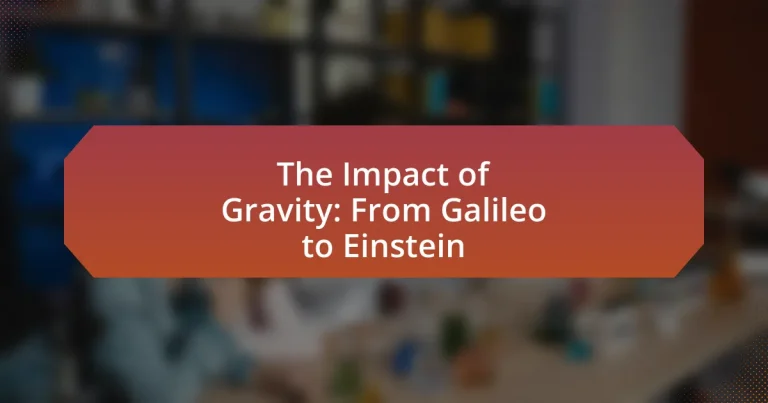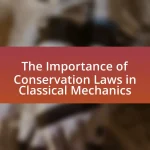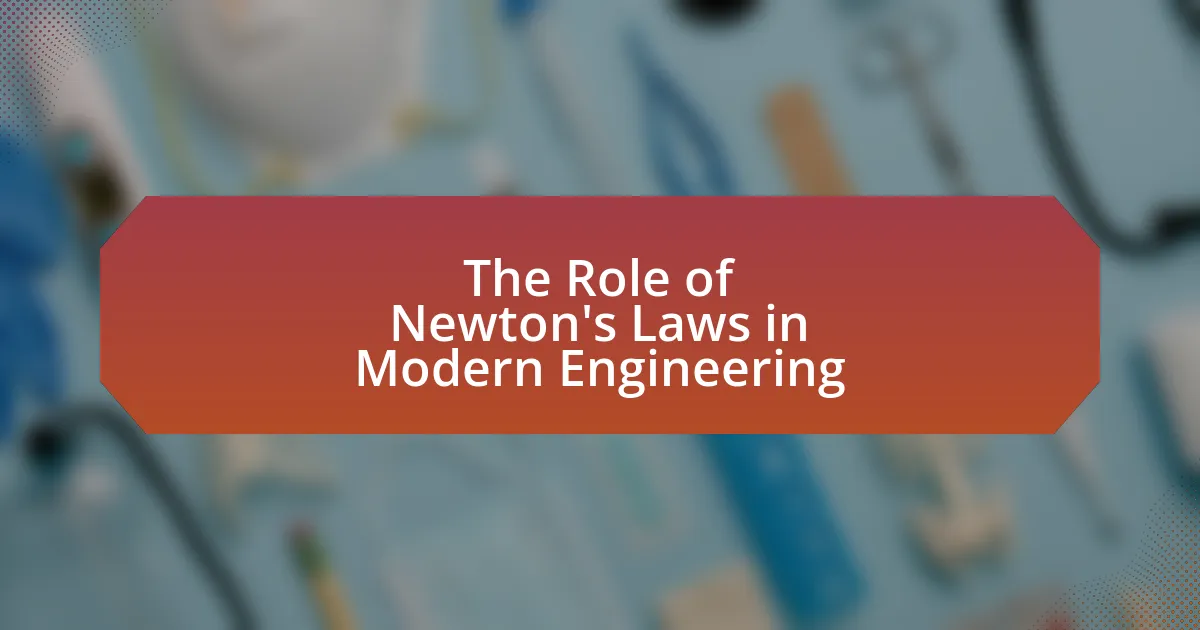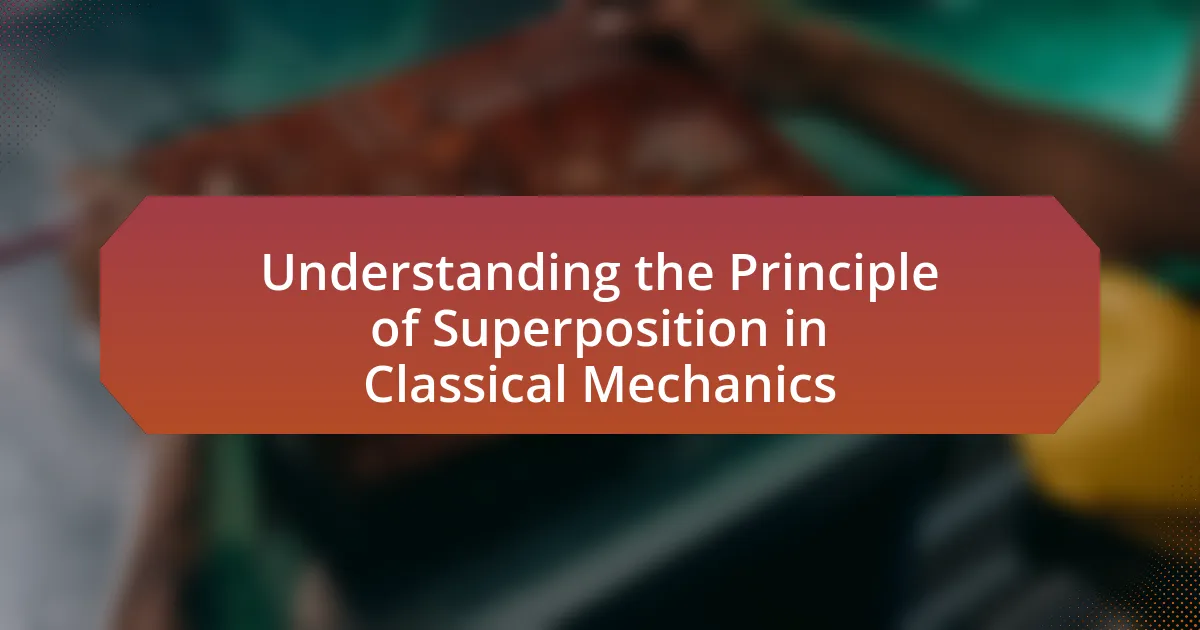The article “The Impact of Gravity: From Galileo to Einstein” examines the historical significance of gravity in shaping scientific understanding. It traces the evolution of gravitational theories, starting with Aristotle’s early notions, through Galileo’s groundbreaking experiments that established the law of falling bodies, to Newton’s formulation of the laws of motion and universal gravitation. The discussion culminates with Einstein’s theory of general relativity, which redefined gravity as the curvature of spacetime. The article highlights the implications of these developments for modern physics, technology, and ongoing research in astrophysics and cosmology.

What is the significance of gravity in the history of science?
Gravity is significant in the history of science as it fundamentally shaped our understanding of the universe and the laws governing motion. The work of Galileo in the late 16th century demonstrated that objects fall at the same rate regardless of their mass, challenging Aristotelian views. Isaac Newton’s formulation of the law of universal gravitation in the 17th century provided a mathematical framework that explained both terrestrial and celestial phenomena, laying the groundwork for classical mechanics. Albert Einstein’s theory of general relativity in the early 20th century revolutionized the concept of gravity by describing it as the curvature of spacetime caused by mass, fundamentally altering our perception of gravity’s role in the cosmos. These developments illustrate gravity’s central role in advancing scientific thought and inquiry, influencing fields such as physics, astronomy, and cosmology.
How did early thinkers perceive gravity before Galileo?
Early thinkers perceived gravity primarily as a force that caused objects to fall towards the Earth, often attributing this phenomenon to the natural tendency of heavy objects to seek their “natural place.” Aristotle, for instance, posited that heavier objects fall faster than lighter ones due to their inherent qualities. This view dominated for centuries until Galileo challenged it by conducting experiments that led to a more nuanced understanding of gravitational acceleration. The prevailing belief before Galileo lacked empirical evidence and relied heavily on philosophical reasoning rather than scientific experimentation.
What were Aristotle’s views on gravity and motion?
Aristotle believed that gravity was a natural tendency of objects to move toward their natural place, with heavier objects falling faster than lighter ones. He posited that all earthly objects strive to reach the center of the Earth, which he considered their natural position. This view was based on his observations of falling objects and the idea that motion is influenced by the nature of the object itself. Aristotle’s theories on motion were foundational in ancient philosophy and remained influential until the scientific revolution, despite being later challenged by figures like Galileo and Newton.
How did the scientific community respond to Aristotle’s theories?
The scientific community initially accepted Aristotle’s theories, particularly his views on motion and gravity, which dominated Western thought for nearly two millennia. However, during the Renaissance, scholars began to challenge these ideas, leading to significant advancements in scientific understanding. For instance, Galileo’s experiments in the late 16th century contradicted Aristotle’s assertion that heavier objects fall faster than lighter ones, demonstrating instead that all objects fall at the same rate in a vacuum. This shift marked the beginning of a transition from Aristotelian physics to a more empirical approach, ultimately paving the way for Newtonian mechanics.
What contributions did Galileo make to our understanding of gravity?
Galileo made significant contributions to our understanding of gravity by demonstrating that objects fall at the same rate regardless of their mass. He conducted experiments, such as rolling balls down inclined planes, which showed that the distance fallen is proportional to the square of the time taken. This led to the formulation of the law of falling bodies, which contradicted the prevailing Aristotelian belief that heavier objects fall faster. Galileo’s observations laid the groundwork for Newton’s later laws of motion and universal gravitation, establishing a scientific basis for understanding gravitational acceleration.
How did Galileo’s experiments challenge existing beliefs about gravity?
Galileo’s experiments challenged existing beliefs about gravity by demonstrating that objects fall at the same rate regardless of their mass. Prior to Galileo, Aristotelian physics posited that heavier objects fell faster than lighter ones. Through his inclined plane experiments and the famous Tower of Pisa demonstration, Galileo showed that the time it takes for an object to fall is independent of its weight, as all objects accelerate uniformly under gravity. This empirical evidence laid the groundwork for Newton’s laws of motion and fundamentally altered the understanding of gravitational forces.
What is the significance of Galileo’s law of falling bodies?
Galileo’s law of falling bodies is significant because it established that all objects fall at the same rate regardless of their mass, provided air resistance is negligible. This principle challenged the prevailing Aristotelian view that heavier objects fall faster than lighter ones. Galileo’s experiments, particularly those conducted at the Leaning Tower of Pisa, demonstrated that the acceleration due to gravity is constant for all objects, leading to the formulation of the law of uniform acceleration. This foundational understanding laid the groundwork for Newton’s laws of motion and the universal law of gravitation, fundamentally transforming the study of physics and our comprehension of motion and gravity.
How did Newton’s laws of motion and universal gravitation expand on Galileo’s work?
Newton’s laws of motion and universal gravitation expanded on Galileo’s work by providing a comprehensive framework that unified terrestrial and celestial mechanics. While Galileo established foundational concepts such as inertia and the uniform acceleration of falling bodies, Newton formalized these ideas into three laws of motion, which describe how objects behave under various forces. Additionally, Newton’s law of universal gravitation introduced the concept that every mass attracts every other mass with a force proportional to the product of their masses and inversely proportional to the square of the distance between their centers. This principle not only explained the motion of planets and moons but also connected the previously separate realms of earthly and celestial physics, thereby solidifying the scientific understanding of gravity as a universal force.
What are Newton’s three laws of motion?
Newton’s three laws of motion are fundamental principles that describe the relationship between the motion of an object and the forces acting on it. The first law, known as the law of inertia, states that an object at rest stays at rest, and an object in motion continues in motion with the same speed and in the same direction unless acted upon by a net external force. The second law establishes that the acceleration of an object is directly proportional to the net force acting on it and inversely proportional to its mass, expressed mathematically as F=ma. The third law states that for every action, there is an equal and opposite reaction, meaning that forces always occur in pairs. These laws, formulated by Sir Isaac Newton in the late 17th century, laid the groundwork for classical mechanics and have been validated through extensive experimentation and observation in physics.
How do these laws relate to the concept of gravity?
The laws of motion and universal gravitation are fundamentally interconnected with the concept of gravity. Isaac Newton’s laws of motion describe how objects move in response to forces, while his law of universal gravitation quantifies the attractive force between two masses, stating that this force is proportional to the product of their masses and inversely proportional to the square of the distance between them. This relationship illustrates that gravity is not just a force acting on objects but is also a key factor influencing their motion, as demonstrated by the orbits of planets and the trajectories of projectiles. Newton’s formulation provided a mathematical framework that allowed for the prediction of gravitational effects, which was pivotal in advancing our understanding of celestial mechanics and the behavior of objects under gravitational influence.
What is the law of universal gravitation and its implications?
The law of universal gravitation states that every mass attracts every other mass in the universe with a force that is directly proportional to the product of their masses and inversely proportional to the square of the distance between their centers. This fundamental principle, formulated by Isaac Newton in 1687, implies that gravitational forces govern the motion of celestial bodies, leading to predictable orbits and interactions between planets, moons, and stars. The law has profound implications, including the understanding of planetary motion, the behavior of tides, and the structure of galaxies, fundamentally shaping our comprehension of the universe and laying the groundwork for modern physics, including Einstein’s theory of general relativity, which further refines our understanding of gravity.
Why was Newton’s work a turning point in the study of gravity?
Newton’s work was a turning point in the study of gravity because he formulated the law of universal gravitation, which quantitatively described the gravitational force between two masses. This law established that every mass attracts every other mass in the universe with a force proportional to the product of their masses and inversely proportional to the square of the distance between their centers. Newton’s publication of “Philosophiæ Naturalis Principia Mathematica” in 1687 provided a mathematical framework that unified terrestrial and celestial mechanics, demonstrating that the same gravitational principles apply to both falling objects on Earth and the motion of planets. This groundbreaking approach laid the foundation for classical mechanics and significantly advanced the scientific understanding of gravity, influencing future research and theories, including those of Einstein.
How did Newton’s theories influence subsequent scientific thought?
Newton’s theories fundamentally transformed scientific thought by establishing the principles of classical mechanics and universal gravitation. His laws of motion and the law of universal gravitation provided a framework that explained both terrestrial and celestial phenomena, influencing thinkers such as Laplace and Einstein. Newton’s work laid the groundwork for the scientific method, emphasizing empirical evidence and mathematical formulation, which became central to later scientific inquiry. The publication of “Philosophiæ Naturalis Principia Mathematica” in 1687 marked a pivotal moment, as it not only unified the understanding of motion and forces but also inspired the Enlightenment, leading to advancements in physics, astronomy, and engineering.
What were the limitations of Newtonian gravity?
Newtonian gravity has several limitations, primarily its inability to accurately describe gravitational phenomena in extreme conditions. For instance, it fails to account for the effects of gravity on light, as demonstrated by the bending of light around massive objects, which was later explained by Einstein’s theory of general relativity. Additionally, Newtonian gravity does not incorporate the concept of spacetime, treating gravity as a force acting at a distance rather than a curvature of spacetime caused by mass. This limitation becomes significant in scenarios involving very massive bodies or high velocities, where Newtonian predictions diverge from observed results, such as the precession of Mercury’s orbit. These discrepancies highlight the need for a more comprehensive framework, which was provided by Einstein’s theories.

What advancements did Einstein bring to the understanding of gravity?
Einstein advanced the understanding of gravity through his General Theory of Relativity, published in 1915. This theory redefined gravity not as a force but as a curvature of spacetime caused by mass. Einstein’s equations demonstrated how massive objects like planets and stars warp the fabric of spacetime, leading to the phenomenon of gravitational attraction. The prediction of light bending around massive objects, confirmed during the 1919 solar eclipse, provided empirical evidence for his theory, solidifying its acceptance in the scientific community.
How does Einstein’s theory of general relativity differ from Newtonian gravity?
Einstein’s theory of general relativity differs from Newtonian gravity primarily in its conceptualization of gravity. While Newtonian gravity describes gravity as a force acting at a distance between two masses, general relativity posits that gravity is the curvature of spacetime caused by mass. This means that massive objects like planets and stars warp the fabric of spacetime, and objects move along the paths dictated by this curvature, rather than being pulled by a force.
The proof of this difference is evident in the predictions made by both theories; for instance, general relativity accurately predicts the bending of light around massive objects, a phenomenon observed during solar eclipses, which Newtonian gravity cannot explain. Additionally, general relativity accounts for the precise orbit of Mercury, which deviates from Newtonian predictions due to the effects of spacetime curvature near the Sun.
What is the concept of spacetime in Einstein’s theory?
The concept of spacetime in Einstein’s theory combines the three dimensions of space with the dimension of time into a single four-dimensional continuum. In this framework, events are described by four coordinates: three spatial dimensions and one temporal dimension, fundamentally altering the understanding of gravity and motion. Einstein’s theory posits that massive objects cause a curvature in spacetime, which influences the motion of other objects, a principle encapsulated in the general theory of relativity. This theory was validated through observations such as the bending of light around massive bodies, first confirmed during a solar eclipse in 1919, demonstrating that spacetime is not merely a backdrop but an active participant in the dynamics of the universe.
How does general relativity explain gravitational phenomena differently?
General relativity explains gravitational phenomena differently by describing gravity not as a force but as a curvature of spacetime caused by mass. In this framework, massive objects like planets and stars warp the fabric of spacetime around them, leading to the observed effects of gravity, such as the orbit of planets around the sun. This concept was validated through various experiments, including the observation of light bending around massive objects during a solar eclipse in 1919, which confirmed Einstein’s predictions and demonstrated that gravity influences the path of light.
What are the implications of Einstein’s theories for modern physics?
Einstein’s theories, particularly the theory of relativity, have profound implications for modern physics, fundamentally altering our understanding of space, time, and gravity. The general theory of relativity, formulated in 1915, introduced the concept that gravity is not a force but a curvature of spacetime caused by mass, which has been validated through numerous experiments, such as the observation of light bending around massive objects during solar eclipses. This shift in perspective has led to advancements in cosmology, including the understanding of black holes and the expansion of the universe, as evidenced by the discovery of cosmic microwave background radiation. Additionally, Einstein’s mass-energy equivalence principle, encapsulated in the equation E=mc², has been pivotal in nuclear physics, influencing both energy production and the development of atomic weapons. Thus, Einstein’s contributions have not only reshaped theoretical frameworks but have also driven technological innovations and deepened our comprehension of the universe.
How has general relativity been tested and confirmed through experiments?
General relativity has been tested and confirmed through various experiments, including the observation of gravitational waves and the bending of light around massive objects. The detection of gravitational waves by the LIGO observatory in 2015 provided direct evidence of the predictions made by general relativity regarding the collision of black holes. Additionally, the bending of light, first confirmed during a solar eclipse in 1919 by Arthur Eddington, demonstrated that light follows the curvature of spacetime caused by gravity, as predicted by Einstein. Other confirmations include the precise measurements of the precession of Mercury’s orbit and the time dilation effects observed in GPS satellites, which account for relativistic effects to maintain accuracy. These experiments collectively validate the principles of general relativity through empirical evidence.
What role does gravity play in contemporary astrophysics and cosmology?
Gravity is fundamental in contemporary astrophysics and cosmology as it governs the structure and dynamics of the universe. It influences the formation of galaxies, stars, and planetary systems, dictating how matter interacts on both large and small scales. For instance, the theory of general relativity, formulated by Albert Einstein, describes gravity as the curvature of spacetime caused by mass, which has been validated through observations such as the bending of light around massive objects and the precise movements of celestial bodies. Additionally, gravity plays a crucial role in the expansion of the universe, affecting the rate of cosmic expansion and the behavior of dark energy, as evidenced by measurements from the Hubble Space Telescope and the Cosmic Microwave Background radiation studies.
What practical applications arise from our understanding of gravity?
Understanding gravity leads to practical applications such as satellite technology, which relies on gravitational principles for orbit stability. Satellites, including GPS systems, utilize gravity to maintain their orbits around Earth, allowing for accurate positioning and navigation services. Additionally, gravity assists in the design of structures and transportation systems, ensuring stability and safety in engineering projects. For instance, the calculations of gravitational forces are essential in constructing bridges and skyscrapers, as they must withstand gravitational pull. These applications demonstrate how our comprehension of gravity directly influences technology and infrastructure in everyday life.
How does gravity influence technology such as GPS and satellite systems?
Gravity significantly influences technology such as GPS and satellite systems by affecting the time dilation experienced by satellites in orbit. According to Einstein’s theory of general relativity, gravity causes time to pass more slowly in stronger gravitational fields. This means that satellites in lower orbits, where gravitational pull is stronger, experience time at a different rate compared to clocks on Earth.
For instance, GPS satellites orbit approximately 20,200 kilometers above Earth, where they experience less gravitational pull than on the surface. As a result, their onboard clocks run faster than those on Earth by about 38 microseconds per day. If this discrepancy were not corrected, GPS calculations would accumulate significant errors, leading to inaccuracies in positioning.
The necessity of accounting for these relativistic effects is crucial for the precision of GPS technology, which relies on accurate timing to determine locations. Therefore, gravity’s influence on time is a fundamental factor in the functionality of satellite systems like GPS.
What are the implications of gravity research for future scientific exploration?
Gravity research has significant implications for future scientific exploration, particularly in understanding fundamental forces and the structure of the universe. Insights gained from gravity studies can enhance our comprehension of phenomena such as black holes, gravitational waves, and the expansion of the universe. For instance, the detection of gravitational waves by LIGO in 2015 confirmed predictions made by Einstein’s General Theory of Relativity, opening new avenues for astrophysical research and observation. This advancement allows scientists to explore cosmic events that were previously undetectable, thereby expanding our knowledge of the universe’s origins and evolution. Furthermore, ongoing research into gravity may lead to breakthroughs in technologies such as satellite navigation and quantum computing, which rely on precise measurements of gravitational effects.




